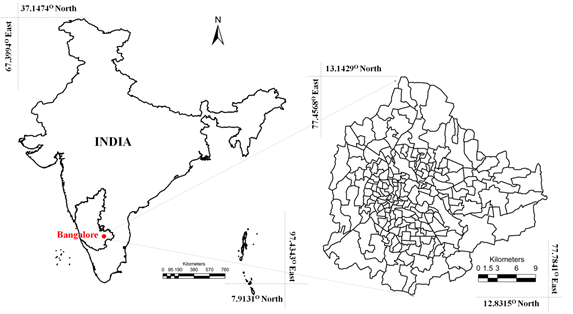
Figure 2.1: Bangalore (Bengaluru) City
|
KORAMANGALA FLOODS: CAUSES |
| Mismanagement of Landscape: Abuse of Bellandur-Agara wetlands, Narrowing and Concretising RajaKaluve and encroachment of storm water drains, Dumping of solid waste & building debris, Apathy of Civic Agencies |
| T.V. Ramachandra Vinay S Bharath H. Aithal |
|
|
Most efficient way of rainwater harvesting is through lakes, which also help in mitigating floods, ground water recharge and sustain local livelihood (fish, fodder, etc.)

Figure 2.1: Bangalore (Bengaluru) City
Growth of Bangalore from Pete’s to Bruhat Bengaluru: Bangalore, the pride to India as the garden and cool city, is about 500 years old has grown from a small time settlement when Kempe-Gowda, the architect of Bengaluru, built a mud fort in 1537 and his son marked the city boundaries by erecting four watch towers. Within the fort the town was divided into pete’s (commercial localities) such as Chickpete, Dodpete, Balepete, Cottonpete and other areas earmarked for different trades and artisans. The town had two main streets, Chickpete Street ran east to west and Dodpete Street ran north to south, their intersection forming Dodpete Square, the heart of Bangalore. Chikkadeva Raya Wodeyar (1673 AD- 1704 AD) built an oval shaped fort south of the old mud fort. Later, Hyder Ali took over the throne until the British defeated him in 1790. During this period, the oval fort in the south was rebuilt with stone and palace was built within the fort, the town was about 5 kilometer’s in circumference, with the fort at the south end, with well-planned streets and prosperous shops indicating a flourishing economy. A big market stretched from the north gate of the town to the oval fort, a predecessor of today’s Avenue Road. Hyder Ali and Tippu Sultan also contributed towards the beautification of the city by building Lalbag Garden in 1760 AD, developed Bangalore into a commercial and military centre of strategic importance. The British after defeating Hyder Ali and Tippu Sultan, ceased Bangalore as strategic stronghold and built military base and cantonment in the city. Sooner Bangalore fort slowly passed into extinction, while the fort walls coming down in stages to make way for the expanding city. The Parade Ground, surrounded by a ride or mall called Rotten Row, was more or less the heart of Bangalore Cantonment. Around this, the Civil & Military Station (CMS) was developed. A civilian population of lower economic strata, attracted by the opportunities for employment and trade and offering subsidiary services to the military personnel, settled in a high density and congested locality. This area evolved into a general bazaar called Blackpally, today’s Shivajinagar. During the British rule, several developments, led to the rapid growth of the city. The most important of these being the telegraph connections introduced to and from Bangalore to all the important cities of India in 1853 AD and the rail connection to Madras in 1864 AD. Hence, with city walls receding, giving way to an unprecedented growth with sprawl at ouskirts. By 1881 AD, Bangalore had two nuclei: one a high-density area around the fort and its market (K.R. Market area) in pete and the second Blackpally (Russel Market area) within the colonial city. Both of these comprised the inner city of Bangalore with Cubbon Park acting as a large green buffer. Several suburbs were built, by 1931 AD the CMS’s population was 134,113 and that of Bangalore was 308,000. Post-Independence the colonial cities were merged in 1949 since then Bangalore was retained the capital of Karnataka state. Bangalore continued to grow and several public sector industries were setup between 1940 and 1970 transforming the city to science and technology centre. By 1961, Bangalore had become the 6th largest city in India with a population of 1,207,000. Between 1971 and 1981, Bangalore’s growth rate was 76%, the fastest in Asia. By 1988 the Electronic City had been developed and Bangalore emerged as India’s software capital. Consequently the 1990’s saw a construction boom fuelled by Bangalore’s growing reputation as “India’s silicon valley”. Since the construction boom, many legal and illegal activities/developments has led to increase in land conversion from one form to constructed and paved surfaces violating the norms (CDP’s). Table 2.1 lists chronologically the increase in city’s spatial extent since 1700 (http://www.karnataka.com; https://archive.org/details/BangaloreGazetteer1875).
Table 2.1: Spatial increase of Bangalore city
Era |
Year |
Area in sq.km |
Hyder Ali and Tippu Sultan |
1700 - 1790 |
2 |
British |
1800 - 1947 |
69 |
Mysore |
1951 |
69 |
BDA |
1963 - 1964 |
112 |
BDA |
1969 |
134 |
BDA |
1979 |
161 |
BDA |
1995 |
226 |
BBMP |
2006 |
696 |
BBMP |
2011 |
741 |
The decadal (during 2001 to 2011) increase in population for urban areas of India is 31.8% and in Karnataka is 31.5%, but Bangalore has a decadal increase of 44%, higher compared to that of the state and country. The decadal population (w.r.t BBMP limits) has increased from 5.8 Million (in 2001) to 8.4 Million (in 2011); the population density has increased from 7880 persons per square kilometer to over 11330 persons per square kilometer. Characterized by undulating topography with green cover and water bodies, the temperature varies from 22oC to 38oC during summer and 14oC to 27oC in winter. Bangalore receives an annual average rainfall of 800 mm. The undulating terrain (varying from about 700 m to about 962 m AMSL) in the region aided in the formation of interconnected lakes in the region.
Geologically, the prevailing rocks are light to dark grey Biotite Granitic Gneiss and varies from place to place in texture, structure and appearance based on the fineness or coarseness of the grains, mode of disposition of dark minerals. The dark minerals are mostly biotite mica are generally arranged in parallel orientation, the light coloured are silicious minerals. The gneissic rocks have portions of uniform granitic texture; these gneissic masses have been styled as ‘Peninsular Gneiss’. Schist’s are not prominent, but isolated stringers of dark hornblend granulite are with light green pyroxene rocks. Other rocks include the dykes and dolerites. Kaolin is a good variety of clay, found in the silts of the lake (http://www.geosocindia.org).
Bangalore City was once aptly known as ‘city of lakes’ due to the presence of large number of lake (about 285 lakes). These lakes were all interconnected with canals / drains (kaluveys’s) to enable transferring excess water to the next lake. These lakes catered the basic needs such as maintaining and recharging ground water, drinking water to the surrounding people, habitat for fishes and other aquatic ecosystems, sustaining food (fish, etc.) and agricultural activities, etc.
The drainage network in Bangalore carries water to the River Cauvery through its tributaries Arkavathi, Pinakini or Pennar and Shimsha. The central, northern and eastern portion is undulating with the upland tracts occupied by scrubs, while the low lands occupied by series of tanks formed by embanking the streams along the valley. These valleys consists of varying size water bodies from small ponds to large lakes. The southern portion of the land consists of hills that are close together and are surrounded by thick jungles.
Bangalore being located on the ridge, forms three watersheds as precipitation flows as runoff in three directions along the valleys (Figure 2.2) - Koramangala Challaghatta Valley (K&C Valley), Hebbal Valley (H Valley) and the Vrishabhavati Valley (V Valley). Under the administrative boundary of Bruhat Bengaluru, K&C valley is the largest encompassing an area of 255 square kilometers, followed by Hebbal valley with an area of 207 square kilometers and Vrishabhavati valley with an area of 165 square kilometers. Both K&C valley and Hebbal valley joins at Nagondanahalli village (BBMP Ward 94 – Hagadur) which further flow to Dakshina Pinakini River, where as Vrishabhavati valley joins Arkavathi river which is a tributary of river Cauvery.
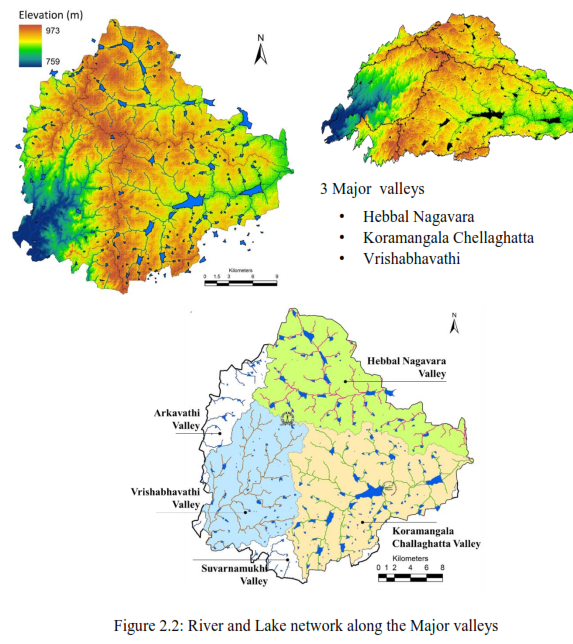
The number of lakes in Bangalore has reduced from nearly 285 (spatial extent of Bangalore: 161 sq.km. in early seventies) to 194 (spatial extent of Bangalore: 741 sq.km. in 2006). Unplanned rapid urbanisation during late nineties, witnessed large-scale unrealistic, uncontrolled developmental activities in the neighborhood of lakes, which led to
Anthropogenic activities particularly, indiscriminate disposal of industrial effluents and sewage wastes, dumping of building debris have altered the physical, chemical as well as biological integrity of the ecosystem. This has resulted in the ecological degradation, which is evident from the current ecosystem valuation of wetlands. Valuation of goods and services from a relatively pristine wetland in Bangalore shows the value of Rs. 10,435/ha/day (much higher than global coastal wetland ecosystems with a total annual of US$ 14,785/ha), while the polluted wetland shows the value of Rs.20/ha/day (Ramachandra et al., 2005) and sewage fed Varthur wetland has a value of Rs.119/ha/day (Ramachandra et al., 2011). The pollutants and subsequent contamination of the wetland has telling effects such as disappearance of native species, dominance of invasive exotic species (such as African catfish, water hyacinth, etc.), in addition to profuse breeding of disease.
2.1 RAINFALL IN BANGALORE |
Rainfall or precipitation data was collected from 18 monitoring stations (Figure 2.3) maintained by Indian Meteorological Department (IMD) and Directorate of Economics and Statistics – Karnataka between 1901 to 2015. 115 years average rainfall data was considered to understand the rainfall dynamics – spatio temporal variability, etc. in Greater Bangalore (Figure 2.4). Spatial Analysis of rainfall indicates that the western portion of Bangalore receives higher rainfall than the east. Monthly analysis (Figure 2.3, Figure 2.4) of rainfall indicated that rainfall in Bangalore is spread across 7 months i.e., 86.9% of rainfall occurs between the months of May to November, September being the highest with average rainfall of 156 mm (Figure 2.5).
Annual rainfall pattern (Figure 2.6) indicates higher variability in rainfall with respect to mean. The trend line and the moving averages indicate increasing rainfall
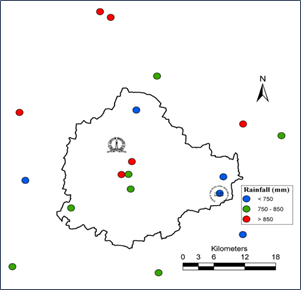
Figure 2.3: Rain gauge stations
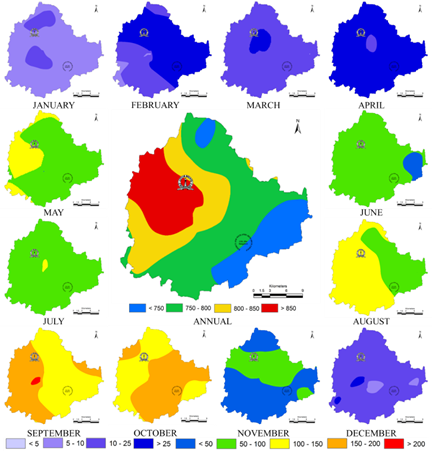
Figure 2.4: Spatial rainfall distribution pattern (all units in mm)
.

Figure 2.5: Monthly rainfall variations
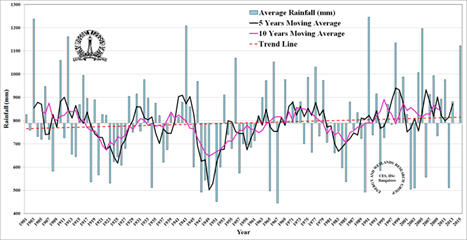
Figure 2.6: Annual rainfall variations (hyetograph)
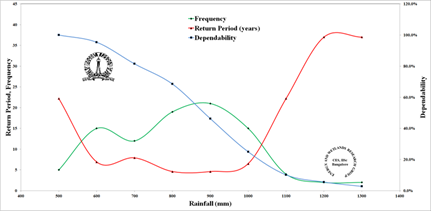
Figure 2.7: Rainfall characteristics - frequency, dependability (%) and return period (years)
Statistical analysis (Figure 2.7, Table 2.1) of annual rainfall indicates that average annual rainfall in Bangalore is 787 mm with 75% dependability and return period of 5 years. The coefficient of variation is 0.23 which indicates that there would be 23% variability in rainfall between consecutive years (http://dimtecrisk.ufs.ac.za/nc/precipitation.html). Rainfall distribution as per the IMD classification (http://www.imd.gov.in) of rainfall conditions nearly 67.7% of the time at least normal rainfall can be observed in Bangalore, 20.7% drought and 11.7% deficient rainfall conditions. The return period of normal rainfall is 3.5 years.
Table 2.1: Rainfall characteristics
Rainfall (mm) |
Frequency |
Probability of Occurrence |
Dependability |
Return Period (years) |
||||||
500 |
5 |
0.05 |
100.0% |
22 |
||||||
600 |
15 |
0.14 |
95.4% |
7 |
||||||
700 |
12 |
0.13 |
81.5% |
8 |
||||||
800 |
19 |
0.22 |
68.5% |
5 |
||||||
900 |
21 |
0.22 |
46.3% |
5 |
||||||
1000 |
15 |
0.15 |
25.0% |
7 |
||||||
1100 |
4 |
0.05 |
10.2% |
22 |
||||||
1200 |
2 |
0.03 |
5.6% |
37 |
||||||
1300 |
2 |
0.03 |
2.8% |
37 |
||||||
Minimum |
445 mm |
Maximum |
1245 mm |
|||||||
Mean |
787 mm |
Median |
784 mm |
|||||||
Standard Deviation |
±184 mm |
Coefficient of Variation |
0.23 |
|||||||
Indian Meteorological Department – Rainfall distribution all India scenario |
||||||||||
Rainfall Distribution |
Condition |
Rainfall |
Probability of Occurrence |
Return Period (Year) |
||||||
Excess |
> 10% Average |
> 866 mm |
0.369 |
2.7 |
||||||
Normal |
± 10% Average |
709 – 866 mm |
0.288 |
3.5 |
||||||
Deficient |
10% > Average< 20% |
630 – 709 mm |
0.117 |
8.5 |
||||||
Drought |
20% > Average< 40% |
472 – 630 mm |
0.207 |
4.8 |
||||||
Severe Drought |
> 60% Average |
< 472 mm |
0.018 |
55.5 |
||||||
2.2 WATER YIELD |
Runoff yield in Bangalore is calculated spatially based on the empirical equation (eq 1) using GIS
Q = C*A*P/1000 ………1
(Raghunath, 1985; Subramanya 2005; Ramachandra et al., 2013, Ramachandra et al 2014)
Where, Q = runoff in cubic meters; C = runoff coefficient (depends on land use of each pixel); C = 0.85 – 0.95 for paved surfaces (Built-up); C = 0.40 – 0.60 for open/agriculture and horticulture; A = area (pixel or catchment) in square meters; P = precipitation as mm
Runoff (mm/year) is depicted in figure 2.8 and higher surface runoff were observed in the localities with higher paved surfaces. Water retaining capacity in the catchment is higher dominated by vegetation cover and water bodies, and with this, lower overland flow or surface run-off were observed during monsoon.
Catchment wise water yield analysis indicates that about 49.5% (7.32 TMC) in the Vrishabhavathi valley (including Arkavathi and Suvarnamukhi), followed by 35.2% (5.2 TMC) in Koramangala Challaghatta valley and 15.3% (4.2 TMC) in Hebbal valley and the total annual water yield is about 14.80 TMC.

Figure 2.8: Runoff (mm/year) in Bangalore
2.3 STATUS OF LAKES – SCOPE FOR HARVESTING RAINWATER |
The number of lakes in Bangalore has reduced from nearly 285 (1970’s; spatial extent of Bangalore is 161 sq.km) to 194 (2016; spatial extent is 741 sq.km). During the last four decades there has been 79% reduction in water bodies and the number of lakes in Bangalore is given in Figure 2.9.

Figure 2.9: Status of Lake in Bangalore
(Red colour indicate lost lakes between 1970’s to 2016)
During 1800, there were 1452 water bodies with the storage capacity of 35 TMC (in the current spatial extent of 741 sq.km.). The current capacity of lakes (193 lakes) is about 5 TMC and due to siltation, the current storage capacity of the lakes is just about 1.2 TMC, i.e., nearly 387 hectares of water bodies lost apart from reduction in the storage capacity by 60%. Bangalore being located on the ridges, forms three watersheds – Koramangala Challagatta valley, Vrishbhavathi valley and Hebbal Nagavara valley. Earlier rulers of the region, created interconnected lake systems taking advantage of undulating terrain. Number of lakes in Koramangala Challaghatta valley is about 81, followed by the Vrishabhavathi valley (56) and the Hebbal Nagavara valley (46). In order to enhance the water retaining capability in the catchment, it is essential to harvest rain water. Lakes are the optimal means of rainwater harvesting at community level. This entails
Sufficient water is available to meet everyone’s requirement (Figure 2.10: Optimal water management through 5R’s): (i) water harvesting is undertaken through surface water bodies (14.8 TMC); this requires rejuvenation of lakes and reestablishment of interconnectivity; harvesting of rainwater (at decentralized levels), treatment; (ii) treatment and reuse of sewage (16.04 TMC). However, the success of sustainable water path depends on the political will, bureaucracy shedding their colonial style of functioning and more importantly citizen’s assertion for their right for equal quantity and quality of water.
Availability |
Water yield (rain) |
14.80 TMC |
|
Sewage (generation 20.05 TMC) if treated |
16.04 TMC |
|
Total |
30.84 TMC |
Demand |
Domestic purposes (@ 150 lpcd) |
20.05 TMC |
Status |
Surplus |
10.79 -12.50 TMC |
|
||
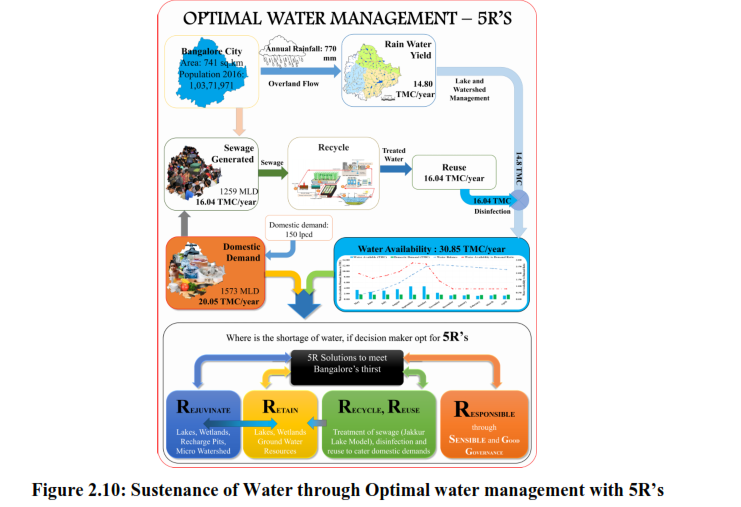
| Contact Address : | |||
| Dr. T.V. Ramachandra Energy & Wetlands Research Group, Centre for Ecological Sciences, TE 15, New Biology Building, Third Floor, E Wing, [Near D Gate], Indian Institute of Science, Bangalore – 560 012, INDIA. Tel : 91-80-22933099 / 22933503-extn 107 Fax : 91-80-23601428 / 23600085 / 23600683 [CES-TVR] E-mail : cestvr@ces.iisc.ac.in, energy@ces.iisc.ac.in, Web : http://wgbis.ces.iisc.ac.in/energy |
|||